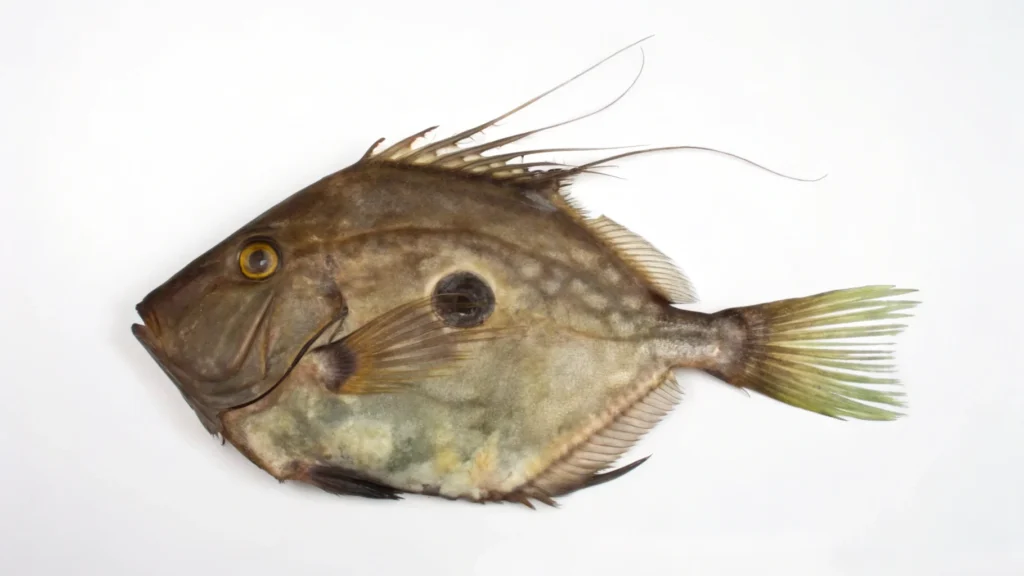
Have you ever seen a fish that looks like it came from a sea legend? The John Dory is a fish with a unique look. It’s a culinary treasure that will amaze you and make your taste buds dance.
Picture yourself on a rocky coast, watching fishermen bring in their nets. They pull out a mysterious creature with a dark spot. This is the John Dory, also known as St. Peter’s fish. It’s a sea wonder that has fascinated chefs and seafood lovers for years.
Did you know that 55% of British food lovers don’t know about the John Dory? It’s a spiny fish with amazing features. Despite its unusual look, it’s a true seafood treasure. It has a mild, sweet taste that makes simple dishes taste like gourmet meals.
Table of contents
Introduction to John Dory Fish: A Culinary and Marine Marvel
The John Dory fish is a fascinating creature with a long history. It has piqued the curiosity of both seafood enthusiasts and marine biologists. Its legend extends far beyond its underwater home.

Exploring the world of this sea dweller reveals many interesting facts. These facts highlight its legendary status and unique features.
The Legend of St. Peter’s Fish: What Makes John Dory So Special?
The John Dory is also known as St. Peter’s Fish. It has a mystical reputation in maritime folklore. The legend says the dark spot on its side is Saint Peter’s fingerprint.
“A fish with a story as unique as its appearance” – Marine Folklore Experts
Culinary History and Importance: Why John Dory is a Global Delicacy
John Dory’s culinary history spans many continents. It is a favorite among chefs around the world. Its importance in global cuisine is due to several key traits:
- Mild, slightly sweet flavor profile
- Firm, delicate meat texture
- Versatility in various cooking methods
- Rich nutritional value
Overview of Physical Traits: The Distinctive Features of the John Dory Fish
The appearance of John Dory is truly remarkable. Its laterally compressed body and distinctive dark spot make it easy to spot. It lives in Atlantic and Mediterranean waters, up to 200 meters deep.
John Dory represents a fascinating part of marine life and culinary exploration. Global fisheries support millions of fishermen, adding to its allure.
Unique Characteristics of John Dory: What Makes This Seafood Gem Special

The John Dory fish is a true marvel of marine design. Its unique appearance captivates both marine enthusiasts and culinary experts. Known locally as Kovač in the Adriatic region, this fish has a remarkable body structure.
Let’s explore the distinctive fish characteristics that make John Dory truly extraordinary:
- Laterally compressed body with an almost circular shape
- Large, spiny dorsal fins that provide exceptional maneuverability
- A distinctive dark spot on its side, which serves multiple evolutionary purposes
The John Dory can grow up to 90 cm (3 feet) in length. Its grayish coloration helps it blend into the underwater environment. This makes it a master of marine camouflage.
“Nature’s craftsmanship is truly captivating in the John Dory, a remarkable example of evolutionary brilliance.” – Marine Biologist
The famous dark spot on the John Dory is intriguing. It’s believed to confuse predators and prey. The spot acts like a natural optical illusion, showing the incredible adaptive strategies of marine life.
Whether you’re a seafood lover or a marine biology enthusiast, the John Dory’s appearance offers a fascinating glimpse into ocean life’s incredible diversity.
What is so special about John Dory fish?
The John Dory fish is a true marvel in the world of seafood. Its unique features make it fascinating to both marine enthusiasts and chefs.

Unique Body Structure: What Makes John Dory Fish Special?
The John Dory’s body is unlike any other. It has a flat, laterally compressed shape. This makes it stand out in the underwater world.
It can grow up to 65 centimeters long. Its unique shape is truly eye-catching.
The Famous Dark Spot Mystery: Why John Dory Stands Out
The John Dory has a mysterious dark spot on its side. This has long fascinated fishermen and marine biologists.
Local legends say the spot helps the fish defend itself. It might confuse predators or prey in the sea.
- Distinctive dark spot on body
- Potential camouflage mechanism
- Unique visual identification marker
Culinary Value and Popularity: The Delicate Flavor of John Dory Fish
Seafood lovers love the John Dory for its taste. It has a mild, sweet flavor and firm meat. This makes it a favorite among chefs.
Interestingly, only a few Brits know about this amazing fish. Despite this, it’s a culinary treasure waiting to be discovered.
The John Dory: A culinary treasure waiting to be discovered by adventurous seafood enthusiasts.
The John Dory is a remarkable example of marine biodiversity and culinary excellence. Its unique features continue to intrigue experts worldwide.
Habitat and Distribution
The John Dory fish lives in many different marine ecosystems. They can be found in oceans across the globe. This makes them a global marine species.
They call several key marine environments home:
- Atlantic Ocean coastal waters
- Mediterranean Sea regions
- New Zealand coastal territories
- Depths ranging from shoreline to 200 meters
John Dory fish are interesting to study. They live in temperate and subtropical marine zones. They can adapt to many underwater landscapes.
“Nature has uniquely equipped the John Dory to survive across multiple marine ecosystems” – Marine Biology Research Institute
Researchers have found John Dory in complex marine environments. They have special body structures. These help them move through different depths and temperatures.
- Depth range: 0-200 meters
- Water temperature preference: 10-20°C
- Preferred substrate: Rocky and sandy bottoms
Learning about John Dory’s habitat helps us understand marine ecosystems. Their wide distribution shows the need to protect marine environments worldwide.
Culinary Excellence and Taste Profile
John Dory fish is a true gem in the seafood world. It’s loved by chefs and seafood fans for its subtle flavors and delicate texture.
The John Dory flavor is mild and delicate. Its smooth and tender texture makes for a great dining experience.
Flavor Characteristics
The John Dory flavor is gentle and sophisticated. It complements a variety of seasonings and cooking techniques. Seafood lovers enjoy its elegant taste that complements other ingredients.
Texture and Meat Quality
- Lean and firm white meat
- Delicate flaky structure
- Moist when properly cooked
- Thin fillets requiring careful preparation
Nutritional Benefits
Seafood nutrition experts praise John Dory as a top protein source. It offers great health benefits:
- High protein content
- Low in fat
- Rich in essential nutrients
- Contains omega-3 fatty acids
Pacific Dory fillets provide approximately 20 grams of protein per serving, making them an ideal choice for health-conscious individuals.
Choosing John Dory means enjoying a tasty meal and boosting your nutrition.
Preparing and Cooking Methods
Cooking John Dory needs care because of its delicate nature. You must prepare it with precision to keep its flavor and texture. The thin fillets of John Dory need gentle cooking to show off its best qualities.
- Poaching: Gently simmer the fish in flavorful liquid to maintain moisture
- Sautéing: Quick pan-frying with minimal oil preserves delicate flavor
- Steaming: Keeps the fish tender and prevents overcooking
- Broiling: Adds a light crisp exterior while keeping the inside succulent
“The key to perfect John Dory is respecting its delicate nature during cooking.” – Professional Chef’s Tip
Professional chefs say to cook John Dory quickly at medium-high heat. The goal is to achieve a golden, crispy exterior and a moist, tender interior. Use just a little salt, pepper, and lemon to enhance its taste.
Timing is very important. Cook John Dory for 3-4 minutes on each side, depending on its thickness. Check for a translucent center and flaky texture for the best taste and texture in your seafood recipes.
Commercial Value and Market Presence
The John Dory fish is a key player in the global seafood market. It stands out with its unique traits. Knowing its commercial side helps us see its value beyond just food.
Global Demand and Market Trends
The John Dory market is growing fast, with New Zealand leading the way. In the 2022-23 fishing year, Aotearoa-New Zealand’s fishers caught about 323,700 tonnes. This added around $2 billion to the economy.
- Primary export markets include Europe and North America
- High-end restaurants consistently seek John Dory
- Growing interest in sustainable seafood increases demand
Price Points and Seafood Availability
John Dory fish prices have changed a lot. In New Zealand, prices went from $28.44/kg in January 2014 to $44.15/kg in January 2024. These changes come from different things:
- Seasonal fishing conditions
- Operational costs for fisheries
- Global market trends
Seasonal Considerations
John Dory is available all year, but its availability changes. Water temperature, breeding cycles, and fishing rules affect supply. This can lead to price changes based on the season.
“Understanding market dynamics helps seafood enthusiasts make informed purchasing decisions.”
Sustainability and Fishing Practices
It’s important to know about sustainable fishing to protect our oceans and keep John Dory available for the future. Fisheries worldwide are working on conservation plans. These plans aim to protect the environment while also meeting fishing needs.
John Dory fishing uses several key methods to be sustainable:
- Trawling with regulated net sizes
- Selective longlining techniques
- Careful catch monitoring
- Implementing marine protected areas
The status of John Dory in the ocean needs careful watching. It’s not in danger, but we must fish responsibly to keep fish numbers healthy. By choosing sustainable seafood, we help protect the ocean.
Sustainable fishing is not only about the harvest today but also about preserving marine ecosystems for the generations to come.
When buying John Dory, look for certifications from groups that protect the sea. These labels show that the fish was caught in a way that’s good for the ocean. The USDA says we should eat at least 8 ounces of seafood each week. So, choosing sustainable seafood is very important.
Here are some key points for sustainable John Dory fishing:
- Tracking fish population levels
- Protecting breeding grounds
- Using selective fishing equipment
- Supporting local fishing communities
By choosing sustainable fishing, we can enjoy John Dory and help protect the ocean’s life.
Popular Recipes and Serving Suggestions
John Dory recipes take you on a tasty journey through seafood. They show how versatile this fish is in the kitchen. Whether you cook at home or in a restaurant, these dishes will make your meals special with their unique taste.
Traditional Preparations
Traditional John Dory recipes keep things simple. Chef Marcus Sherry from Artfarm’s Fish Shop says to focus on the fish’s soft texture:
- Select a large John Dory fish from the bone
- Use fresh ingredients like yellow and green courgettes
- Incorporate ripe cherry tomatoes and fresh herbs
Modern Culinary Applications
Modern John Dory dishes are all about being creative. The recipe suggests grilling the fish slowly, flipping every 4-5 minutes for perfect doneness. Try these modern twists:
- Tropical fruit salsa with pineapple, mango, and papaya
- Mango vinegar reduction
- Couscous accompaniment
Wine Pairing Recommendations
The right wine can transform your John Dory dining experience from good to extraordinary.
For wine pairing with John Dory, choose crisp white wines. They match well with its mild flavor. New Zealand white wines are great, balancing the fish’s taste perfectly.
Pro tip: March and April are the best months to find fresh Scottish seafood. This ensures your John Dory recipes are top-notch.
Cultural Significance and Traditions
The John Dory fish has a rich history that goes beyond its taste. It’s deeply woven into fish folklore, captivating people worldwide for ages.
One legend surrounds its dark spot. It’s called St. Peter’s Fish and holds religious meaning. The spot is said to be Saint Peter’s thumbprint, adding a magical touch to its story.
In the world of cultural significance, the John Dory serves as a symbol of the connection between marine life and human storytelling.
The John Dory’s importance changes in different places:
- Mediterranean coastal communities see it as a spiritual symbol
- European fishing traditions celebrate its unique look
- Religious stories often feature the John Dory’s special features
In many coastal areas, the John Dory is more than just food. It connects the natural world with human culture, showing the deep bond between sea creatures and our stories.
Purchasing Guide and Storage Tips
Choosing and storing John Dory needs careful attention for the best quality. When buying John Dory, make choices that promise a great taste experience.
Selection Criteria for Fresh John Dory
Finding the perfect John Dory means knowing what to look for. Your selection should focus on key freshness signs:
- Clear, bright eyes without cloudiness
- Firm, elastic flesh that springs back when touched
- Mild ocean-like scent without strong fishy odors
- Vibrant, consistent coloration
Expert Storage Methods
Proper fish storage is key to keeping John Dory’s quality. Follow these tips for professional fish storage:
- Refrigerate immediately after purchase
- Store on ice or in the coldest part of your refrigerator
- Use within 1-2 days for optimal freshness
- Keep fish wrapped in clean, damp paper towels
“The secret to great seafood is freshness and proper handling.” – Culinary Expert
Freshness Indicators to Trust
When buying John Dory, trust your senses. Fresh fish should look and smell good. Visual and sensory cues are your best guide to a high-quality catch that will make your meal better.
Conclusion
Exploring John Dory shows us a fish with special qualities. It’s not just any seafood. Its delicate taste and unique texture make it stand out. This fish is a favorite in kitchens around the world.
John Dory’s qualities go beyond its looks. Its meat is firm and flaky, with a mild taste. This makes it great for many dishes. Whether you’re a pro chef or cooking at home, it’s a chance to make something special.
Thanks to sustainable fishing, we can keep enjoying John Dory. By choosing this fish, you help protect our oceans. It’s more than food; it connects us to the sea and its traditions.
John Dory’s dark spot and delicious meat show the ocean’s wonders. Your adventure with this fish is a mix of art and taste. It invites you to dive deeper and enjoy its unique qualities.
FAQs:
1. Is John Dory a good fish to eat?
Yes, it’s prized for its mild, sweet flavor and delicate texture.
2. Why is John Dory fish so expensive?
Limited availability, thin fillets, and high demand make it costly.
3. What is John Dory fish called in the USA?
It’s commonly called “John Dory” or “St. Peter’s Fish.”
4. What is the difference between King Dory and John Dory?
King Dory is larger, but John Dory is more popular for its flavor and iconic dark spot
